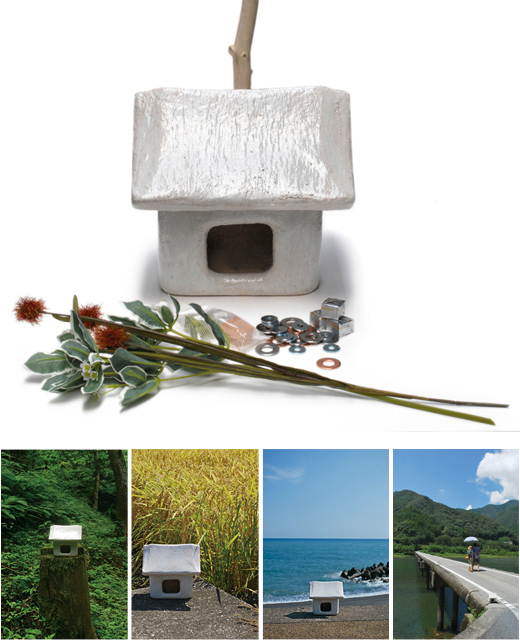
| Title of work | Hokkori-sama |
| Concept of the work | Even in metropolitan areas which are packed with buildings, trees still grow robustly within the precincts of shrines. Although Japan is known as a country which ignores religion, it seems that there is an intangible power at work. The Hokkori-sama proposed here is a small item to stimulate the sensations which lay dormant in Japanese people. Hokkori-sama is used by subtly placing it in front of a view which you wish to convey to the future. When Japanese people find Hokkori-sama, they will offer flowers and small coins, clasping their hands and bowing their heads in prayer. Furthermore, they will implicitly receive a heartfelt message that this view must not be destroyed. The cultural climate of Japan seems to imbue an empty box with the function of protecting the view of a beautiful landscape. Since before the Kojiki (A Record of Ancient Matters) and Nihon-Shoki (Chronicles of Japan) were written, the Japanese have invited gods to a variety of locations and have continued to protect such locations as sacred ground. Through Hokkori-sama, it would be wonderful if the very customs and culture of the Japanese people became a method for conveying views of landscape to future generations. |
| Judge's Comment | It is very symbolic and ironical that this work won the prize for the Spatial Division. This proposal can be described as a figurative tool which is placed in a certain location, thus allowing viewers to once again experience the importance of nature and to correct the atmosphere of their lives. The work is in the shape of a hokora (a small shrine), which is an extremely Japanese design. From the perspective of creating a shared symbol for the world, perhaps it would have been better to use a shape like that of the monolith which appeared in the film "2001: A Space Odyssey". Such a monolith would have the simple appearance of a flat board but would contain a spiritual presence. Another shape which could have been used is hardened sand which would disappear with the passage of time. This kind of material would eventually return to nature. In contrast to other submitted works which sought to greatly change metropolitan or rural landscapes, this work sought to stop the hectic flow of time in today's life and to allow the viewer to reflect upon the world and society. The presentation and language used gave a poetic impression. |
| Name of Applicant | Fuyuma Yano |  |
| Year of Birth | 1984 | |
| Gender | Male | |
| Nationality | Japan | |
| Occupation | Ito Heizaemon Architectural Office | |
| Academic History | Finished Tokyo University of Science, Graduate School of Science and Technology, ,Department of Architecture | |
| Awards |
MITSUBISHI CHEMICAL JUNIOR DESINGER AWARD 2009 - Special Judge's Award Exhibition of Student Works for Master's Degree at Tokyo University of Science 2009 – Excellent Award The 1st KomyMirror Competition 2008 – Honorable Mention |
|